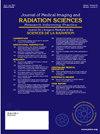水激发提高了食管癌弥散加权磁共振成像的成像质量:与频谱衰减反转恢复弥散加权成像的比较
IF 1.3
Q3 RADIOLOGY, NUCLEAR MEDICINE & MEDICAL IMAGING
Journal of Medical Imaging and Radiation Sciences
Pub Date : 2024-10-01
DOI:10.1016/j.jmir.2024.101497
引用次数: 0
摘要
目的与标准频谱衰减反转恢复(SPAIR)相比,确定扩散加权成像(DWI)中的水激发(WE)能否改善食管癌患者的图像质量。每位患者都使用 3T 磁共振扫描仪进行了 WE-DWI 和 SPAIR-DWI。两名放射科医生采用四点评分法对两个序列的整体图像质量、脂肪抑制的均匀性、病变的清晰度和伪影进行独立评估。此外,还测量并计算了肿瘤最大切片的定量表观弥散系数(ADC)值、信噪比(SNR)和对比度与噪声比(CNR)。采用加权卡帕检验和相应的类内相关系数(ICC)评估观察者之间的一致性。结果两名独立放射科医生之间的定性评估(加权卡帕值为 0.626-0.760)和定量评估(ICC:0.768-0.968)的观察者间一致性良好。WE-DWI的总体图像质量、脂肪抑制的均匀性和病变的清晰度均明显高于SPAIR-DWI(均为p<0.001)。两种序列的伪影评分无明显差异(P=0.093)。SPAIR-DWI的信噪比和CNR均高于WE-DWI(均为p<0.05)。在肿瘤的平均 ADCs 方面,WE-DWI 和 SPAIR-DWI 没有明显差异(p=0.101)。本文章由计算机程序翻译,如有差异,请以英文原文为准。
Water-excitation improves the image quality of diffusion-weighted MR imaging in esophageal cancer:Comparison with spectral attenuated inversion recovery diffusion-weighted imaging
Purpose
To determine whether water-excitation (WE) in diffusion-weighted imaging (DWI) can improve the image quality in patients with esophageal cancer compared with standard spectral attenuated inversion recovery (SPAIR).
Materials and Methods
Twenty-two patients Clinically diagnosed with esophageal cancer were enrolled in this study. For each patient, both WE-DWI and SPAIR-DWI were performed using a 3T MR scanner. Two radiologists independently assessed the overall image quality, homogeneity of fat suppression, lesion conspicuity and artifacts of two sequences by using a four-point scale. The quantitative apparent diffusion coefficient (ADC) value, signal-to-noise ratio (SNR) and contrast-to-noise ratio (CNR) were also measured and calculated on the largest slice of the tumor. The interobserver agreement was evaluated using a weighted Kappa test and the respective intraclass correlation coefficient (ICC). Comparisons of the quantitative and qualitative parameters were performed using the paired t-test and the Wilcoxon signed rank test.
Results
The interobserver agreement between two independent radiologists was good for qualitative assessments (weighted kappa value 0.626-0.760) and quantitative evaluations (ICC:0.768-0.968). The overall image quality, homogeneity of fat suppression and lesion conspicuity of WE-DWI were all significantly higher than those of SPAIR-DWI (all p<0.001). There was no significant difference in artifacts scores between the two sequences(p=0.093). The SNR and CNR were all higher in SPAIR-DWI than those in WE-DWI (all p<0.05). There was no significant difference between WE-DWI and SPAIR-DWI with regard to mean ADCs of the tumor (p=0.101)
Conclusion
Diffusion-weighted imaging with water-excitation is a clinically useful technique to improve the image quality for the purpose of evaluating lesions in patients with esophageal cancer.
求助全文
通过发布文献求助,成功后即可免费获取论文全文。
去求助
来源期刊

Journal of Medical Imaging and Radiation Sciences
RADIOLOGY, NUCLEAR MEDICINE & MEDICAL IMAGING-
CiteScore
2.30
自引率
11.10%
发文量
231
审稿时长
53 days
期刊介绍:
Journal of Medical Imaging and Radiation Sciences is the official peer-reviewed journal of the Canadian Association of Medical Radiation Technologists. This journal is published four times a year and is circulated to approximately 11,000 medical radiation technologists, libraries and radiology departments throughout Canada, the United States and overseas. The Journal publishes articles on recent research, new technology and techniques, professional practices, technologists viewpoints as well as relevant book reviews.
 求助内容:
求助内容: 应助结果提醒方式:
应助结果提醒方式:


